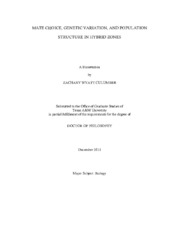| dc.description.abstract | Natural hybrid zones provide opportunities to study a range of evolutionary phenomena from speciation to the genetic basis of fitness-related traits. Additionally, investing the structure of hybrid zones can provide valuable insight in the ecology and evolution of species. The present dissertation approaches the investigation of natural hybrid zones between Xiphophorus birchmanni and X. malinche from a population genetics perspective. The goal of the chapters herein are to investigate the genetic structure of these natural hybrid zones overall and the genetic structure of the populations within them in an effort to better understand the factors producing and maintaining spatial genetic patterns among this species pair and their hybrids.
Using informative single nucleotide polymorphisms (SNPs) in one mitochondrial and three nuclear intron loci, I show that hybrid zones occur in replicated fashion in multiple stream reaches along a gradient from high to low elevation. Tests of FIS and linkage disequilibrium (LD) revealed significant genetic structure within a small subset of populations. Specifically, parentals and hybrids all three occur in some locations while other locations appear to be hybrid swarms.
I then investigated a behavioral mechanism of reproductive isolation - social association, which might affect population structure. In clean water, individuals shoaled significantly more closely with conspecifics. Additionally, genotyping of females and their embryos revealed signatures of non-random mating in structured populations. Taken together, assortative social grouping, which may translate to assortative female mate choice, likely plays a role in maintaining population structure. Finally, I show that fluctuating asymmetry is significantly higher in unstructured than structure populations. This is a further indication that some form of non-random mating occurs in structured populations and has effects on male phenotypes. | en |


